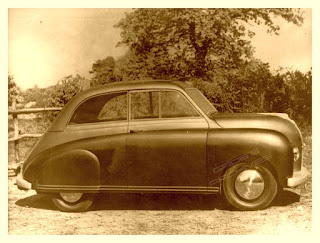Vintage Thing no.57.1 - Little Jimmy
 |
| English by looks but rear-engined in nature (Photo : Saco) |
When I wrote about Little Jim in my original post, there was a conspicuous gap in the narrative. Some details about the pre-war Little Jim were known to me but the next prototype for a very small car for the Rootes group was even more mysterious.
All we had to go on was a mention in the Henshaw's book about the Hillman Imp, Apex - The inside story of the Hillman Imp. This, of course, was the eventual flowering of the small car concept developed by Rootes. In the Henshaw's book, Little Jimmy is described as rear-engined and powered by a two-cylinder version of a Volkswagen air-cooled motor.
These pictures of Little Jimmy popped up on the Auto Puzzles website in 2014 and eventually appeared via a link on the Imp Club Facebook page.
 |
| What's that coming over the hill? (Photo : Grobmotorix archive) |
It took a while for the puzzle to pan out. By a process of elimination, the Rootes group were eventually identified and Craig Miller credited with the design of this 1949 prototype christened "Little Jimmy". Posted by arch-autopuzzler Grobmotorix, these photos were purchased by him at an auto fair a few years ago, probably Tecnica Classica at Essen in Germany, from a UK dealer in automobilia.
Little Jimmy's basic concept probably wouldn't have set the world on fire. It sounds terribly under-powered and looks very narrow to modern eyes. I reckon Craig Miller was influenced by the Jowett Javelin and although the proportions look uncomfortable, the styling is more successful than the razor-edged Triumph Mayflower.
.
In searching for more info on Little Jim or Little Jimmy, I found an intriguing article on AROnline, which deals mostly with Austin-Rover history. Along with other manufacturers, Sir William Rootes was involved in the post war viability assessment of the Volkswagen. Each one rejected it but Sir William is the one mostly cited as the one who thought the car was likely to fail although it's well-known that Austin and Ford in the US also thought Beetle cars were a silly idea.
Little Jimmy is effectively a British-version of a Beetle and none the better for it.
The philosophy of Heinz Nordhoff was at odds with the "export or die" mantra prevalent in post war UK and the emphasis on badge engineering that followed. His attention to quality and customer satisfaction polished the Beetle from what could have been quite a dull car. He listened to customers and understood their needs. Output was all that mattered to other contemporary manufacturers. Recalls and rectification work were not adequately addressed by the British motor industry and that ultimately ruined the Hillman Imp's reputation, not to mention the Morris Marina, the Austin Allegro and many others I could mention.
In one of those parallel universes I mention from time to time, Little Jimmies entered production and gained a reputation to rival to the VW Beetle. Unfortunately, that didn't happen in ours





Little Jimmy is also briefly mentioned in Battle for the Beetle by Karl Ludvigsen.
ReplyDeleteVaguely recall reading of a connection between the Little Jimmy motor and the Volkspflug prototype although that was said to have featured a different motor.
The VW derived Twins found in both DAFs and the Brazilian Gurgel cars would give a rough approximation of Little Jimmy's limited prospects compared to the Beetle, maybe a BMW influenced Twin motor would have helped matters as utilized on the Orix 610, Panhards, Puch 500 and temporarily by BMW themselves from a getting more out of less approach (e.g. 50 hp from a 850cc Twin vs 50 hp from a 1600cc Flat-Four)?
The Villers developed flat twin originally intended for Slug and Apex is another interesting could have been. I think the little four cylinder the Imp ended up with gave it much more of a grown up car.
DeleteThe Henshaw describes the 600cc air-cooled Flat-Twin Villiers engine as noisy and none-too-powerful, while a Curbside Classic article on the Imp claims the Villiers engine featured a hemi-head and was based on a Motorcycle engine.
DeleteOtherwise remarkably little information seems to exist about the Villiers engine, whether it was simply an all-new design that never found its way to a motorcycle, what its design influences were or if it did somehow find its way into a motorcycle what specific model it powered as taken together it would give a better idea of the Villiers engine's prospects.
The Imp indeed turned out to be much more of grown up car compared to the earlier prototypes, even if it was handicapped in terms of design and am not even referring to its rear-engined layout.